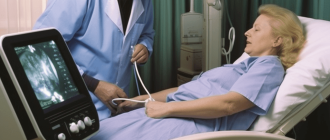 Understanding Mesenteric Thrombosis: Causes, Symptoms, and Treatment
Understanding Mesenteric Thrombosis: Causes, Symptoms, and Treatment
Mesenteric thrombosis is a rare but serious condition that occurs when a blood clot forms in one of the arteries that supply blood to the intestines. This can lead to a decrease in blood flow to the intestines, causing tissue damage and potentially life-threatening complications.
There are two main types of mesenteric thrombosis: acute mesenteric thrombosis and chronic mesenteric thrombosis. Acute mesenteric thrombosis occurs suddenly and is often caused by a blood clot that forms in the mesenteric artery, blocking blood flow. Chronic mesenteric thrombosis, on the other hand, develops over time and is usually caused by a buildup of fatty deposits in the arteries.
The symptoms of mesenteric thrombosis can vary depending on the severity of the condition. Common symptoms include severe abdominal pain, nausea, vomiting, diarrhea, and bloody stools. If left untreated, mesenteric thrombosis can lead to bowel infarction, which is the death of intestinal tissue due to lack of blood supply.
Diagnosis of mesenteric thrombosis typically involves a combination of medical history evaluation, physical examination, and imaging tests such as CT scan, ultrasound, or angiography. Treatment options for mesenteric thrombosis may include medications to dissolve the blood clot, surgery to remove the clot or bypass the blocked artery, and lifestyle changes to reduce the risk of future blood clots.
Mesenteric thrombosis is a serious condition that requires prompt medical attention. Early diagnosis and treatment are crucial for preventing complications and improving outcomes. If you experience severe abdominal pain or other symptoms associated with mesenteric thrombosis, it is important to seek medical help immediately.
What is a mesenteric thrombosis?
Mesenteric thrombosis, also known as mesenteric venous thrombosis, is a rare but serious condition that occurs when a blood clot forms in the veins that supply blood to the intestines. The mesenteric veins are responsible for draining blood from the intestines and carrying it back to the heart. When a blood clot blocks the flow of blood through these veins, it can lead to severe damage and death of the intestinal tissue.
Mesenteric thrombosis can be caused by a variety of factors, including blood clotting disorders, underlying medical conditions such as liver disease or cancer, abdominal surgery, trauma to the abdomen, certain medications, and dehydration. The condition is more common in older adults and individuals with a history of blood clotting disorders.
The symptoms of mesenteric thrombosis can vary depending on the extent of the clot and the affected area of the intestines. Common symptoms include severe abdominal pain, nausea, vomiting, diarrhea, bloody stools, and fever. If left untreated, mesenteric thrombosis can lead to complications such as intestinal ischemia (lack of blood flow to the intestines), bowel infarction (tissue death), and sepsis (infection).
Diagnosis of mesenteric thrombosis typically involves a combination of medical history review, physical examination, and imaging tests such as ultrasound, CT scan, or angiography. Treatment options may include anticoagulant medications to dissolve the blood clot, thrombolytic therapy to break up the clot, and surgery to remove the clot or repair any damaged intestines.
Prevention of mesenteric thrombosis involves managing underlying risk factors such as blood clotting disorders and staying hydrated, as well as avoiding prolonged periods of immobility and maintaining a healthy lifestyle. It is important to seek immediate medical attention if you experience severe abdominal pain or other symptoms suggestive of mesenteric thrombosis.
What are the defining characteristics of a mesenteric thrombosis?
A mesenteric thrombosis is a condition characterized by the formation of a blood clot in one or more of the mesenteric arteries, which supply blood to the intestines. This can lead to a blockage in the blood flow and cause severe damage to the intestines.
Some of the defining characteristics of a mesenteric thrombosis include:
- Sudden and severe abdominal pain: One of the main symptoms of mesenteric thrombosis is the sudden onset of intense abdominal pain. This pain is often severe and may be accompanied by nausea and vomiting.
- Loss of appetite: People with mesenteric thrombosis may experience a loss of appetite due to the pain and discomfort in the abdomen.
- Diarrhea or constipation: Changes in bowel movements, such as diarrhea or constipation, may occur as a result of the reduced blood flow to the intestines.
- Bloody stools: In some cases, mesenteric thrombosis can cause the passage of bloody stools. This is due to the damage to the intestines caused by the lack of blood flow.
- Fever: A low-grade fever may be present in some individuals with mesenteric thrombosis. This is often a sign of inflammation in the affected area.
- Abdominal tenderness: The abdomen may feel tender to touch, especially in the area where the blood clot is located.
- Rapid heartbeat: An increased heart rate may be observed in some cases of mesenteric thrombosis. This is a result of the body’s response to the reduced blood flow.
If you experience any of these symptoms, it is important to seek immediate medical attention, as mesenteric thrombosis is a serious condition that requires prompt treatment to prevent further complications.
Where does a mesenteric thrombosis usually occur?
A mesenteric thrombosis typically occurs in the mesenteric arteries, which are the blood vessels that supply oxygen-rich blood to the intestines. It is most commonly found in the superior mesenteric artery, which is the large artery that arises from the aorta and provides blood to the small intestine and part of the large intestine.
However, mesenteric thrombosis can also occur in the inferior mesenteric artery, which supplies blood to the lower part of the large intestine. In some cases, both the superior and inferior mesenteric arteries may be affected by thrombosis.
When a thrombosis forms in these arteries, it can block or reduce blood flow to the intestines, leading to various complications and potentially life-threatening conditions such as mesenteric ischemia and bowel infarction.
It is important to note that mesenteric thrombosis is a relatively rare condition, but it can have serious consequences if not diagnosed and treated promptly. Risk factors for developing mesenteric thrombosis include age, certain medical conditions such as atrial fibrillation and hypercoagulable disorders, and a history of blood clotting disorders.
What veins are typically involved?
Mesenteric thrombosis occurs when a blood clot forms in one of the veins that supply blood to the mesentery, which is the tissue that connects the intestines to the abdominal wall. The mesenteric veins that are typically involved in this condition are the superior mesenteric vein (SMV) and the inferior mesenteric vein (IMV).
The SMV is the main vein that drains blood from the small intestine, cecum, ascending colon, and transverse colon. It is responsible for carrying nutrient-rich blood back to the liver for processing. The IMV, on the other hand, drains blood from the descending colon and sigmoid colon before joining the splenic vein.
In cases of mesenteric thrombosis, blood clots can form in these veins, blocking the normal blood flow and causing ischemia in the intestines. If left untreated, this can lead to severe complications such as bowel infarction and tissue death.
It is important to note that mesenteric thrombosis is a serious medical condition that requires immediate medical attention. If you experience symptoms such as severe abdominal pain, nausea, vomiting, or bloody stools, it is important to seek medical help right away.
What is mesenteric vein thrombosis?
Mesenteric vein thrombosis (MVT) is a rare condition characterized by the formation of blood clots in the veins that drain blood from the intestines. The mesenteric veins are responsible for carrying oxygen-depleted blood away from the intestines and back to the heart. When a blood clot forms in one or more of these veins, it can block the flow of blood, leading to serious complications.
MVT can occur as a result of several factors, including blood clotting disorders, liver disease, abdominal surgery, certain medications, and cancer. In some cases, the exact cause of MVT may be unknown.
The symptoms of MVT can vary depending on the extent of the clot and the affected veins. Common symptoms include severe abdominal pain, nausea, vomiting, diarrhea, and blood in the stool. If left untreated, MVT can lead to intestinal ischemia (lack of blood flow to the intestines), which can cause tissue death and perforation of the intestines.
Diagnosis of MVT often involves a combination of imaging tests, such as ultrasound, CT scan, and angiography. Blood tests may also be performed to check for clotting disorders or other underlying conditions.
Treatment for MVT typically involves anticoagulant medications to dissolve the blood clot and prevent further clotting. In some cases, surgery may be necessary to remove the clot or repair any damage to the intestines. The underlying cause of MVT, if known, will also be addressed to prevent future episodes.
Overall, mesenteric vein thrombosis is a serious condition that requires prompt medical attention. If you experience severe abdominal pain or other symptoms of MVT, it is important to seek medical help right away.
What is superior mesenteric vein thrombosis icd 10?
Superior mesenteric vein thrombosis (SMVT) is a rare but serious condition characterized by the formation of blood clots in the superior mesenteric vein, which is responsible for draining blood from the small intestine, large intestine, and other abdominal organs.
The International Classification of Diseases, 10th Revision (ICD-10) is a coding system used by healthcare providers and researchers to classify and code diagnoses, symptoms, and procedures. In the case of superior mesenteric vein thrombosis, the appropriate ICD-10 code is K55.1.
This code specifically refers to nonpyogenic thrombosis of the portal vein, which includes thrombosis of the superior mesenteric vein. The ICD-10 code provides a standardized way to document and track cases of superior mesenteric vein thrombosis, allowing for accurate statistical analysis and research.
Diagnosing superior mesenteric vein thrombosis requires a combination of clinical evaluation, imaging tests (such as Doppler ultrasound or computed tomography angiography), and laboratory tests to rule out other potential causes and confirm the presence of a blood clot.
Treatment for superior mesenteric vein thrombosis typically involves anticoagulant therapy to prevent the formation of additional blood clots and surgery in severe cases to remove or bypass the clot. Early diagnosis and intervention are crucial to prevent complications such as bowel infarction or sepsis.
Superior mesenteric vein thrombosis is a rare condition involving the formation of blood clots in the superior mesenteric vein. The ICD-10 code K55.1 is used to classify and track cases of this condition, allowing for accurate documentation and analysis. Prompt diagnosis and treatment are essential for optimal patient outcomes.
How does a mesenteric thrombosis differ from a mesenteric embolism?
Both mesenteric thrombosis and mesenteric embolism are conditions that involve the blood vessels supplying the intestines. However, they differ in terms of the underlying cause and mechanism.
Mesenteric thrombosis occurs when a blood clot forms in one of the mesenteric arteries, which are responsible for supplying blood to the intestines. This clot can restrict or block blood flow, leading to tissue damage and potentially life-threatening complications.
On the other hand, mesenteric embolism occurs when a blood clot or other material, such as fat or cholesterol, becomes dislodged from a different part of the body and travels through the bloodstream. Eventually, it reaches one of the mesenteric arteries, where it becomes lodged and blocks blood flow.
While both conditions can result in similar symptoms, such as severe abdominal pain and nausea, the underlying causes are different. Mesenteric thrombosis is often associated with conditions that increase the risk of blood clot formation, such as atherosclerosis, atrial fibrillation, or certain blood disorders. Mesenteric embolism, on the other hand, is more commonly associated with heart conditions, such as atrial fibrillation or a recent heart attack.
Diagnosis and treatment for both conditions are similar, involving imaging tests to visualize the affected blood vessels and interventions to restore blood flow, such as surgery or thrombolytic therapy. However, the specific treatment approach may vary depending on the individual case.
Mesenteric thrombosis and mesenteric embolism are both serious conditions that involve blockage of the blood vessels supplying the intestines. However, mesenteric thrombosis is caused by a blood clot forming within the mesenteric arteries, while mesenteric embolism occurs when a clot or other material travels from elsewhere in the body and becomes lodged in the mesenteric arteries.
What is the difference in origin between a thrombosis and embolism?
Thrombosis and embolism are both medical conditions that involve the blockage of blood vessels, but they differ in their origins.
Thrombosis occurs when a blood clot, known as a thrombus, forms within a blood vessel. This clot can develop due to various factors, such as injury to the blood vessel wall or a disruption in the normal flow of blood. Thrombosis can occur in both arteries and veins and can lead to serious complications if not treated promptly.
Embolism, on the other hand, is the result of a clot or other foreign material, known as an embolus, traveling through the bloodstream and becoming lodged in a blood vessel. The embolus can originate from a thrombus that has formed in another location, such as the heart or a deep vein in the leg. It can also be a result of other substances, such as fat or air, entering the bloodstream. Once the embolus becomes lodged, it can cause a blockage and disrupt blood flow to the affected area.
Thrombosis is the formation of a blood clot within a blood vessel, while embolism is the result of a clot or other foreign material becoming lodged in a blood vessel after traveling through the bloodstream.
| Thrombosis | Embolism |
|---|---|
| Formation of a blood clot within a blood vessel | Blockage caused by a clot or other foreign material becoming lodged in a blood vessel after traveling through the bloodstream |
| Can occur in both arteries and veins | Can occur in various locations depending on the origin of the embolus |
| Caused by factors such as injury to the blood vessel wall or disruption in blood flow | Caused by a clot or other foreign material traveling through the bloodstream |
How do they differ in pathophysiology?
Mesenteric thrombosis and mesenteric ischemia have different pathophysiological mechanisms.
Mesenteric thrombosis occurs when a blood clot forms in one of the mesenteric arteries, obstructing or reducing blood flow to the intestines. This can be caused by various factors, such as atherosclerosis, blood clotting disorders, or embolism from a distant site. The blood clot can completely block the artery, leading to acute mesenteric ischemia, or partially block the artery, causing chronic mesenteric ischemia.
In contrast, mesenteric ischemia refers to the inadequate blood supply to the intestines due to narrowing or constriction of the mesenteric arteries. This can be caused by conditions like atherosclerosis, vasculitis, or low blood pressure. The reduced blood flow can lead to tissue damage and ischemia in the intestines.
While both conditions result in reduced blood flow to the intestines, the underlying causes and mechanisms differ. Mesenteric thrombosis involves the formation of a blood clot, while mesenteric ischemia is primarily caused by narrowing or constriction of the arteries. Understanding these differences is crucial for accurate diagnosis and appropriate management of these conditions.
Where does a mesenteric thrombosis usually form?
A mesenteric thrombosis typically forms within the mesenteric arteries, which are the blood vessels that supply blood to the intestines. These arteries can become blocked or narrowed due to the formation of a blood clot, leading to a mesenteric thrombosis. The clot can occur in any of the mesenteric arteries, including the superior mesenteric artery, the inferior mesenteric artery, or the celiac artery.
When a mesenteric thrombosis forms, it can restrict or completely block blood flow to the intestines, causing severe abdominal pain, nausea, vomiting, and potentially life-threatening complications. The exact location of the thrombosis within the mesenteric arteries can determine the severity and extent of the symptoms experienced by the affected individual.
If left untreated, a mesenteric thrombosis can lead to intestinal ischemia, which is a condition characterized by the inadequate blood supply to the intestines. This can result in tissue damage, bowel necrosis, and even death. Prompt diagnosis and treatment are crucial in order to prevent these complications and preserve the function of the intestines.
Does location differ between thrombosis and embolism?
In cases of mesenteric thrombosis, the blood clot forms directly in the mesenteric blood vessels, usually due to local factors such as atherosclerosis or inflammation. The clot obstructs blood flow to the mesenteric arteries, resulting in ischemia and potential necrosis of the intestines.
On the other hand, mesenteric embolism occurs when a blood clot or other material, such as a fat globule or tumor fragment, travels from a distant location and lodges in the mesenteric arteries. The embolus blocks blood flow to the intestines, leading to similar consequences as thrombosis.
While both thrombosis and embolism lead to mesenteric ischemia and potentially necrosis, the location of the clot or embolus differs. Thrombosis occurs within the mesenteric blood vessels themselves, while embolism involves the migration of a clot or other material to the mesenteric arteries from another part of the body.
This difference in location can have implications for treatment and prognosis. Thrombosis may require more localized interventions, such as thrombolytic therapy or surgical removal of the clot, while embolism may necessitate a broader approach to identify and treat the source of the embolus.
| Thrombosis | Embolism |
|---|---|
| Forms directly in the mesenteric blood vessels | Travels from a distant location and lodges in the mesenteric arteries |
| Usually due to local factors such as atherosclerosis or inflammation | Can be caused by a blood clot, fat globule, tumor fragment, or other material |
| Requires more localized interventions | May necessitate a broader approach to identify and treat the source of the embolus |
What veins are most commonly affected?
Mesenteric thrombosis refers to the formation of blood clots in the veins that supply the intestines. The two main veins that are commonly affected by mesenteric thrombosis are:
| Vein | Description |
|---|---|
| Superior mesenteric vein | This vein is responsible for draining blood from the small intestine, ascending colon, and transverse colon. |
| Portal vein | This vein collects blood from the intestines, spleen, and stomach, and carries it to the liver for processing. |
These veins are crucial for the proper functioning of the digestive system, and when blood clots form in them, it can lead to serious complications. The clot can block blood flow to the intestines, resulting in tissue damage and potentially life-threatening conditions such as intestinal ischemia and infarction.
It’s important to note that while these two veins are the most commonly affected by mesenteric thrombosis, other veins in the mesenteric region can also be involved. Prompt medical attention is crucial if mesenteric thrombosis is suspected to prevent further complications and improve the chances of successful treatment.
What veins can be involved in mesenteric thrombosis?
Mesenteric thrombosis occurs when a blood clot forms in one of the veins that supply blood to the intestines. The primary veins that can be involved in mesenteric thrombosis are:
| Vein | Location |
|---|---|
| Superior mesenteric vein | Located in the abdomen, it drains blood from the small intestine, appendix, and parts of the large intestine. |
| Portal vein | Located in the liver, it collects blood from the intestines, spleen, and stomach, and carries it to the liver for processing. |
| Inferior mesenteric vein | Located in the abdomen, it drains blood from the lower parts of the large intestine. |
When a clot forms in any of these veins, it can obstruct blood flow, leading to mesenteric thrombosis. The lack of blood supply can cause severe abdominal pain, nausea, vomiting, and potentially life-threatening complications if left untreated.
Overview of the venous anatomy related to mesenteric thrombosis
Mesenteric thrombosis is a condition characterized by the formation of blood clots in the veins that supply the intestines. To understand this condition better, it is important to have an overview of the venous anatomy related to mesenteric thrombosis.
The venous system responsible for draining blood from the intestines is known as the mesenteric venous system. This system consists of several veins, including the superior mesenteric vein (SMV), the inferior mesenteric vein (IMV), and their tributaries.
The superior mesenteric vein is the larger of the two main veins in the mesenteric system. It receives blood from the small intestine, cecum, ascending colon, and transverse colon. The superior mesenteric vein then merges with the splenic vein to form the portal vein, which carries blood to the liver.
The inferior mesenteric vein drains blood from the descending colon, sigmoid colon, and rectum. It usually joins the splenic vein before entering the portal vein.
Both the superior and inferior mesenteric veins are susceptible to thrombosis, which can lead to mesenteric thrombosis. The formation of blood clots in these veins can obstruct blood flow, leading to ischemia and potentially life-threatening complications.
Other veins that can be involved in mesenteric thrombosis include the colic veins, which drain blood from the colon, and the rectal veins, which drain blood from the rectum. These veins can also become blocked by blood clots, contributing to the development of mesenteric thrombosis.
Mesenteric thrombosis is a condition that involves the formation of blood clots in the veins of the mesenteric venous system. Understanding the venous anatomy related to this condition is crucial for diagnosing and managing mesenteric thrombosis effectively.
| Venous Anatomy | Main Drainage |
|---|---|
| Superior Mesenteric Vein (SMV) | Small intestine, cecum, ascending colon, transverse colon |
| Inferior Mesenteric Vein (IMV) | Descending colon, sigmoid colon, rectum |
| Colic Veins | Colon |
| Rectal Veins | Rectum |
Which veins are most frequently involved?
Mesenteric thrombosis is a condition in which a blood clot forms in one of the veins that supply blood to the intestines. The two main veins that are most frequently involved in mesenteric thrombosis are the superior mesenteric vein (SMV) and the portal vein.
The superior mesenteric vein is responsible for draining blood from the small intestine, portions of the large intestine, and other abdominal organs. It is a major blood vessel that plays a crucial role in the digestive system. When a blood clot forms in the superior mesenteric vein, it can block the blood flow to the intestines, resulting in severe abdominal pain and potential tissue damage.
The portal vein is another important blood vessel that is often affected by mesenteric thrombosis. The portal vein carries blood from the digestive organs to the liver, where it is processed and detoxified. When a blood clot forms in the portal vein, it can cause a condition known as portal vein thrombosis, which can lead to liver damage and other complications.
In addition to the superior mesenteric vein and the portal vein, other veins in the mesenteric region can also be involved in mesenteric thrombosis, although less frequently. These include the inferior mesenteric vein, the splenic vein, and the gastric veins. The involvement of these veins depends on various factors, such as the location and extent of the blood clot.
| Vein | Function |
|---|---|
| Superior mesenteric vein (SMV) | Drains blood from the small intestine, portions of the large intestine, and other abdominal organs. |
| Portal vein | Carries blood from the digestive organs to the liver for processing and detoxification. |
| Inferior mesenteric vein | Drains blood from the lower parts of the large intestine. |
| Splenic vein | Drains blood from the spleen and portions of the stomach and pancreas. |
| Gastric veins | Drain blood from the stomach. |
What is the pathophysiology of mesenteric thrombosis?
Mesenteric thrombosis is a condition characterized by the formation of blood clots in the mesenteric vessels, which supply blood to the intestines. The pathophysiology of mesenteric thrombosis involves several factors.
- Thrombosis formation: Mesenteric thrombosis occurs when blood clots form within the mesenteric arteries or veins. This can be due to various reasons, including atherosclerosis, blood vessel injury, or hypercoagulable states.
- Reduced blood flow: The presence of blood clots in the mesenteric vessels leads to a reduction in blood flow to the intestines. This reduced blood flow can result in ischemia, or inadequate oxygen supply, to the affected areas of the intestines.
- Tissue damage: Ischemia caused by mesenteric thrombosis can lead to tissue damage in the intestines. Without adequate oxygen and nutrient supply, the intestinal cells cannot function properly, leading to cell death and tissue necrosis.
- Inflammation and infection: Tissue necrosis caused by mesenteric thrombosis can trigger an inflammatory response in the body. This inflammation can further contribute to tissue damage and increase the risk of infection.
- Potential complications: If left untreated, mesenteric thrombosis can lead to serious complications such as bowel infarction, peritonitis, and sepsis. These complications can be life-threatening and require immediate medical intervention.
The pathophysiology of mesenteric thrombosis involves the formation of blood clots, reduced blood flow, tissue damage, inflammation, and potential complications. Understanding these underlying mechanisms is crucial for early diagnosis and appropriate management of mesenteric thrombosis.
Explanation of how a clot develops and impacts blood flow
A clot, also known as a thrombus, can develop in the mesenteric blood vessels, leading to a condition called mesenteric thrombosis. The development of a clot in the mesenteric arteries or veins can have a significant impact on blood flow and the overall functioning of the digestive system.
When a clot forms, it usually starts with the formation of a small blood clot, or a thrombus, on the inner lining of a blood vessel. This initial clot formation can occur due to various factors, such as the damage to the blood vessel wall, abnormal blood flow, or an imbalance in blood clotting factors.
Over time, the clot can grow in size and eventually block the blood vessel partially or completely. This blockage can disrupt the normal blood flow to the mesenteric organs, including the small intestine, large intestine, and other abdominal organs. The reduced blood flow can lead to ischemia, which is a condition characterized by inadequate blood supply to the affected organs.
The lack of blood supply can cause severe abdominal pain, bloating, nausea, vomiting, and diarrhea. If left untreated, mesenteric thrombosis can lead to serious complications, such as bowel infarction (tissue death), peritonitis (inflammation of the abdominal lining), or even sepsis (a life-threatening infection).
It is essential to diagnose and treat mesenteric thrombosis promptly to restore blood flow to the affected organs and prevent further complications. Treatment options may include anticoagulant medications to prevent further clot formation, thrombolytic therapy to dissolve the existing clot, or surgical interventions to remove the clot or bypass the blocked blood vessels.
The development of a clot in the mesenteric blood vessels can significantly impact blood flow to the digestive organs, leading to mesenteric thrombosis. Understanding how a clot develops and its effects on blood flow is crucial for early detection and appropriate management of this condition.
Discussion of risk factors contributing to thrombosis
Mesenteric thrombosis is a serious condition that occurs when a blood clot forms in one of the arteries that supply blood to the intestines. There are several risk factors that can increase the likelihood of developing mesenteric thrombosis. These risk factors can be divided into two categories: acquired and inherited.
Acquired risk factors include conditions or lifestyle choices that can increase the risk of developing blood clots. These can include:
| Acquired Risk Factors |
|---|
| Age: Older adults are at higher risk of developing mesenteric thrombosis. |
| Smoking: Tobacco use can damage blood vessels and increase the risk of clot formation. |
| Obesity: Excess weight can lead to inflammation and increase the risk of clotting. |
| High blood pressure: Hypertension can damage blood vessels and increase the risk of clotting. |
| Diabetes: High blood sugar levels can damage blood vessels and increase the risk of clot formation. |
| Hypercoagulable states: Certain medical conditions or medications can increase the risk of clotting. |
Inherited risk factors refer to genetic factors that can increase the risk of developing blood clots. These can include:
| Inherited Risk Factors |
|---|
| Factor V Leiden mutation: This genetic mutation increases the risk of developing blood clots. |
| Prothrombin gene mutation: This genetic mutation can increase the risk of clot formation. |
| Antiphospholipid syndrome: This autoimmune disorder can increase the risk of clotting. |
It is important to note that having one or more of these risk factors does not guarantee the development of mesenteric thrombosis. However, individuals with these risk factors should be aware of their increased risk and take appropriate measures to prevent blood clots, such as maintaining a healthy lifestyle and following any recommended medical treatments.
How does mesenteric thrombosis relate to MALS?
Mesenteric thrombosis is a condition characterized by the formation of blood clots in the mesenteric arteries, which supply blood to the intestines. This condition can lead to the blockage of blood flow, causing tissue damage and potentially life-threatening complications.
Median arcuate ligament syndrome (MALS) is a separate condition that involves the compression of the celiac artery by the median arcuate ligament, a fibrous band of tissue. This compression can lead to a reduction in blood flow to the abdominal organs, including the intestines.
While mesenteric thrombosis and MALS are distinct conditions, they can be related in some cases. Mesenteric thrombosis can occur as a result of various factors, including conditions that promote blood clot formation, such as MALS. The reduced blood flow caused by MALS can create an environment conducive to the development of blood clots in the mesenteric arteries.
Furthermore, mesenteric thrombosis can also lead to the development or worsening of MALS. The formation of blood clots in the mesenteric arteries can cause inflammation and scarring of the surrounding tissues, including the median arcuate ligament. This scarring can further compress the celiac artery, exacerbating the symptoms of MALS.
It is important to note that not all cases of MALS are associated with mesenteric thrombosis, and not all cases of mesenteric thrombosis are related to MALS. However, when these conditions coexist, they can contribute to a more severe and complicated clinical course.
Overall, the relationship between mesenteric thrombosis and MALS is complex and multifactorial. Further research is needed to better understand the mechanisms underlying their association and to develop more effective diagnostic and treatment strategies.
Description of the connection between MALS and mesenteric thrombosis
Mesenteric artery thrombosis is a condition characterized by the formation of blood clots in the mesenteric arteries, which supply blood to the intestines. MALS, or median arcuate ligament syndrome, is a rare condition that involves compression of the celiac artery by the median arcuate ligament, resulting in decreased blood flow to the abdominal organs.
Research has suggested a potential connection between MALS and mesenteric thrombosis. The compression of the celiac artery in MALS can lead to reduced blood flow and increased turbulence in the mesenteric arteries, making them more prone to the formation of blood clots. This can ultimately result in mesenteric artery thrombosis.
Patients with MALS may experience symptoms such as abdominal pain, weight loss, and diarrhea, which can be similar to those seen in mesenteric thrombosis. Therefore, it is important for healthcare professionals to consider the possibility of mesenteric thrombosis in patients with MALS who present with these symptoms.
Diagnosis of mesenteric thrombosis in patients with MALS can be challenging, as the symptoms can overlap. Imaging studies such as CT angiography or magnetic resonance angiography may be used to assess blood flow and detect the presence of blood clots in the mesenteric arteries.
Treatment of mesenteric thrombosis in patients with MALS typically involves a combination of anticoagulant therapy to dissolve the blood clot and surgical intervention to relieve the compression of the celiac artery caused by the median arcuate ligament. In some cases, a bypass graft may be necessary to restore adequate blood flow to the intestines.
Overall, understanding the connection between MALS and mesenteric thrombosis is crucial for accurate diagnosis and appropriate management of these conditions. Further research is needed to explore the mechanisms underlying this connection and to develop more effective treatment strategies.
How MALS can contribute to developing a thrombosis
MALS (Median Arcuate Ligament Syndrome) is a rare disorder that involves compression of the celiac artery by the median arcuate ligament of the diaphragm. This compression can lead to a variety of symptoms, including abdominal pain, weight loss, and digestive issues. However, recent studies have also suggested a potential link between MALS and the development of mesenteric thrombosis.
Mesenteric thrombosis occurs when a blood clot forms in one of the mesenteric arteries, which supply blood to the intestines. This can lead to a disruption in blood flow and oxygen supply to the intestines, resulting in tissue damage and potentially life-threatening complications.
While the exact mechanism by which MALS contributes to the development of mesenteric thrombosis is not fully understood, several theories have been proposed. One possibility is that the compression of the celiac artery caused by the median arcuate ligament leads to a decrease in blood flow to the intestines. This reduced blood flow may create a pro-thrombotic environment, making it more likely for a blood clot to form.
Another theory suggests that the compression of the celiac artery may cause changes in the endothelial lining of the artery, promoting the formation of blood clots. The endothelium plays a crucial role in maintaining the health and function of blood vessels, and any disruption in its integrity can increase the risk of thrombosis.
Additionally, the chronic inflammation and tissue damage caused by the compression of the celiac artery in MALS may also contribute to the development of thrombosis. Inflammation is known to activate the coagulation cascade, leading to the formation of blood clots.
Further research is needed to fully understand the relationship between MALS and mesenteric thrombosis. However, recognizing the potential link between these two conditions is crucial for early detection and management of mesenteric thrombosis in patients with MALS.
| Key Points |
|---|
| – MALS is a rare disorder involving compression of the celiac artery by the median arcuate ligament of the diaphragm. |
| – MALS may contribute to the development of mesenteric thrombosis, a condition characterized by blood clot formation in the mesenteric arteries. |
| – The exact mechanism by which MALS leads to thrombosis is not fully understood, but theories include reduced blood flow, endothelial changes, and chronic inflammation. |
| – Recognizing the potential link between MALS and mesenteric thrombosis is important for early detection and management of thrombotic complications. |
Q&A:
What are the symptoms of mesenteric thrombosis?
The symptoms of mesenteric thrombosis can vary depending on the severity of the condition. Common symptoms may include severe abdominal pain, nausea, vomiting, diarrhea, and bloody stools.
What causes mesenteric thrombosis?
Mesenteric thrombosis is typically caused by a blood clot that forms in one of the arteries that supply blood to the intestines. This clot can be caused by conditions such as atherosclerosis, blood disorders, or trauma to the abdomen.
How is mesenteric thrombosis diagnosed?
Mesenteric thrombosis can be diagnosed through various tests, including imaging studies such as CT scans or angiography, blood tests to check for elevated levels of certain enzymes, and a physical examination to assess symptoms and signs of the condition.
Is mesenteric thrombosis a life-threatening condition?
Yes, mesenteric thrombosis can be a life-threatening condition if not treated promptly. The lack of blood flow to the intestines can lead to tissue death and infection, which can be fatal if left untreated.
What are the treatment options for mesenteric thrombosis?
Treatment for mesenteric thrombosis may include medications to dissolve the blood clot, surgery to remove the clot or bypass the blocked artery, and lifestyle changes to reduce the risk of future blood clots.
What is mesenteric thrombosis?
Mesenteric thrombosis is a condition in which a blood clot forms in one of the arteries that supply blood to the intestines.
What are the symptoms of mesenteric thrombosis?
The symptoms of mesenteric thrombosis may vary, but commonly include severe abdominal pain, nausea, vomiting, diarrhea, and bloody stools.
How is mesenteric thrombosis diagnosed?
Mesenteric thrombosis can be diagnosed through various imaging tests such as CT scan, MRI, or angiography. Blood tests may also be done to check for signs of clotting.
What are the risk factors for developing mesenteric thrombosis?
Risk factors for mesenteric thrombosis include older age, certain medical conditions such as atrial fibrillation, heart disease, and a history of blood clotting disorders. Smoking, obesity, and a sedentary lifestyle can also increase the risk.






